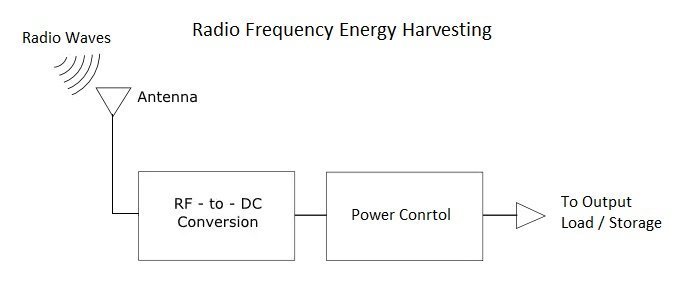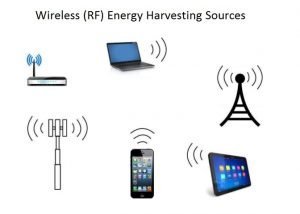자료실
[해외칼럼] RF 무선 에너지 하베스팅의 원리와 응용 분야
- 작성일2023/10/26 15:48
- 조회 284
[번역요약]
에너지는 시스템이 움직이는 데 가장 중요한 요소입니다.
지금, 이 순간에도 RF 에너지는 전 세계에 어디에서든 송신기와 장치로 전송되고 있습니다. 이런 에너지를 주변에서 얻을 수 있다면 많은 장점이 있을 것입니다.
이 글에서는 무선 주파수를 기반으로 하는 무선 에너지 하베스팅이 무엇인지 알아보고자 합니다.
무선(RF) 에너지 하베스팅이란?
에너지 하베스팅은 주변으로부터 에너지를 공급받아 유용한 형태로 변환하여 응용 가능한 전자 장치에 전력을 공급하거나, 나중에 사용하기 위해 저장하는 것입니다.
안테나가 수신한 여러 소스의 전자기 에너지는 전기 에너지로 변환되어 다른 장치의 전원을 공급하는 데 사용합니다.
무선 주파수 에너지 하베스팅은 Wi-Fi 네트워크 및 TV/라디오 송신기 같은 RF 소스로부터 전력을 수집해 RF에너지를 DC 전력으로 변환하여 배터리를 충전하거나 저전력 전자 장치에 전력을 공급하는 데 사용할 수 있습니다.
RF 에너지 하베스팅의 역사
RF 에너지 하베스팅이 처음으로 기록된 것은 1908년 니콜라 테슬라(Nikola Tesla)가 무선 전력 전송을 시연했을 때였습니다.
그 후, 1920년대 초, 굴리엘모 마르코니(Gullielmo Marconi)는 RF 에너지를 사용하여 무선으로 전구와 모터에 전력을 공급하는 실험을 했습니다.
1930년대와 1940년대에는 RF 에너지를 사용해 전력을 공급하는 장치에 대해 많은 특허가 출원되었습니다.
1941년 하인리히 헤르츠(Heinrich Hertz)는 RF 에너지를 사용한 무선 전송 시스템에 관한 내용인 "On the Possibility of Wireless Transmission of Electrical Energy" 라는 논문을 발표하였습니다.
1954 년 아서.C.클라크(Arthur C. Clarke)는 "Extra-Terrestrial Relays – Can Rocket Stations Give Worldwide Radio Coverage?"라는 제목의 논문을 발표했습니다.
이 논문에서 위성을 이용해 전 세계에 무선 신호를 중계하고자 했고, 위성이 태양 전지판이나 지구에서 나오는 빛을 RF 에너지로 전송하여 전력을 공급받을 수 있다고 주장했습니다.
1960 년 피터 글레이저 (Peter Glaser)는 커다란 안테나를 사용하여 태양 복사선을 모아 지구에서 쓸 수 있는 전기 에너지로 변환해 사용하는 파워 비밍(power beaming)이라는 개념을 발표했습니다.
2001년 존 퍼킨(John Perkin)은 TV나 라디오 신호 같은 주변 소스에서 RF 에너지를 모으는 방법에 대한 특허를 내기도 했습니다.
RF 무선 에너지 하베스팅의 작동 원리

RF-EH(Radio Frequency Energy Harvesting /무선 주파수 에너지 하베스팅)은 RF 에너지를 전기 에너지로 변환해 전자 기기에 전력을 공급하는 과정입니다.
일반적인 RF 에너지 하베스팅 장치에는 크게 새 가지 구성 요소가 있습니다.
안테나는 주변 신호를 수신할 수 있는 특정 주파수로 설계되었으며, 전자기파를 저전력 전기 신호로 변환하여 AC-DC 컨버터로 공급합니다.
DC 전압은 부하 또는 스토리지에 대한 출력을 조절하는 제어 장치에 의해 제어됩니다.
전파원
무선 에너지 하베스팅을 위한 전파원으로는 모든 무선 전력 송신 장치가 고려될 수 있습니다.
주파수 범위와 작동 전력은 송신 장치의 특정 응용 분야에 따라 다릅니다.
가장 일반적인 전파원은 이동 기지국, 라디오 방송국, TV 방송, 위성, 무선 LAN 송신기(Wi-Fi) 및 모바일 장치 등입니다.
무선 에너지 하베스팅의 응용 분야
- 배터리 없는 전원
- 쇼핑용 RF 태그
- 스마트 조명 애플리케이션
- ZigBee 기술로 사용하는 홈 스마트 스위치
- 사물인터넷 응용프로그램
- 전자 기기 충전
- 스마트 센서용 전원
- 단순한 설계 및 비용 효율성
- 보다 간편한 구현
무선 에너지 하베스팅의 장점
- 기존 전원을 교체할 수 있습니다.
- 에너지 소스 제공 스펙트럼이 무한합니다.
- 에너지원을 효율적으로 사용할 수 있습니다.
- 에너지 낭비가 없으며 친환경적 입니다.
- 주기적으로 배터리를 교체할 필요가 없습니다.
- 절전 모드 시 축전지를 재충전하기 때문에 기기 수명이 연장됩니다.
[칼럼원문] 작성자: Rajiv, 출처 : RF based wireless energy harvesting and its applications 에서 일부분 발췌하였습니다.
RF based wireless energy harvesting and its applications

Energy is one of the most important factors for any active system to work. At any given moment, RF energy is transmitted from millions of transmitters and devices across the globe.
There are a lot of advantages if we could harvest this energy from surrounding sources. Let’s find what is Radio Frequency-based based wireless energy harvesting its applications.
We have been depending on many energy sources for centuries. Since the modern science and electronics industry growing rapidly, there is a huge demand for various efficient energy sources.
What is wireless (RF) energy harvesting?
The concept of energy harvesting is to receive energy from surroundings sources and convert it into a useful form to power any applications or store the energy for future usage.
In wireless (RF) energy harvesting, electromagnetic energy from multiple sources received by an antenna, converts into electric energy and use as a power source for other devices.
Radio Frequency energy harvesting technology allows power to be harvested from RF sources such as cellular towers, Wi-Fi networks, and TV/radio transmitters.
he technology converts the RF energy into DC power which can then be used to charge batteries or provide power for low-power electronics.
History
The first recorded use of RF energy harvesting was in 1908 when Nikola Tesla demonstrated the wireless transmission of electricity.
In the early 1920s, Guglielmo Marconi experimented with using RF energy to wirelessly power light bulbs and motors.
In the 1930s and 1940s, several patents were filed for devices that used RF energy to power electronic devices.
In 1941, Heinrich Hertz published a paper entitled “On the Possibility of Wireless Transmission of Electrical Energy”.
This paper described a system for wirelessly transmitting electrical energy using RF waves.
In 1954, Arthur C. Clarke published a paper entitled “Extra-Terrestrial Relays – Can Rocket Stations Give Worldwide Radio Coverage? “. In this paper, Clarke proposed using satellites to relay radio signals around the globe.
He also suggested that these satellites could be powered by solar panels or by beaming RF energy from Earth.
In 1960, Peter Glaser proposed using large antennae to collect solar radiation and convert it into electrical energy that could be beamed down to Earth.
This concept is known as power beaming.
In 2001, John Perkin patented a method for harvesting RF energy from ambient sources such as television or radio signals.
How RF-based wireless energy harvesting works

Radio Frequency energy harvesting (RF-EH) technology is a process by which RF energy is converted into electrical energy that can be used to power electronic devices.
There are mainly three components in a typical RF energy harvesting device.
An antenna is designed and perfectly tuned to a specific frequency that receives signals from its surroundings.
The antenna converts electromagnetic waves into low-power electrical signals which will be fed to an AC to DC converter.
DC voltage will be controlled by a controlling unit that regulates the output to the load or storage.
Sources of radio waves
Any radio transmitting device can be considered as a source for wireless energy harvesting.
The frequency range and operating power depend on the specific application of the transmitter.
The most common radio wave sources are mobile base stations, radio broadcasting stations, TV broadcasting, satellites, wireless LAN transmitters (Wi-Fi), and mobile devices.
Applications of wireless energy harvesting
- Battery-less power source
- RF tags for shopping
- Smart lighting applications
- Smart switches for home automation used with ZigBee technology
- Internet of Things applications
- Recharging of devices
- Power source for smart sensors
- Simple design and cost-effective
- Easier implementation
Advantages of wireless energy harvesting
- Conventional power sources can be replaced
- Unlimited spectrum of sources
- Efficient source of energy
- No wastage, green energy
- No need for periodic replacement of the battery
- Extended life for devices due to recharging of storage battery during sleep mode







